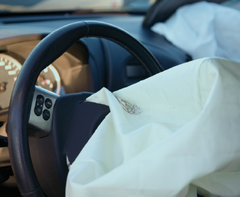The Bosch CDR Tool
Key Applications for Insurance and Law Enforcement Crash Investigators
 When investigating a car accident or insurance claim, no single piece of information can paint a complete picture of what occurred and who was at fault. Law enforcement officers and insurance professionals know this fact all too well.
When investigating a car accident or insurance claim, no single piece of information can paint a complete picture of what occurred and who was at fault. Law enforcement officers and insurance professionals know this fact all too well.
First-hand and eyewitness accounts of the incident are notoriously unreliable. Environmental factors and road debris can change between the occurrence of the event and the on-scene investigation. Video of the incident – if it’s available — may not capture key in-vehicle actions that influenced a crash.
As such, any comprehensive investigation requires a detailed analysis of the various human, vehicular, and environmental factors that may have influenced or caused the event. Within that universe of evidence, an unbiased and reliable source of information has emerged – and even grown more powerful as in-vehicle technology has advanced: The Event Data Recorder (EDR), which is integrated into nearly every car, light truck, and SUV sold in the U.S. since 2013. The EDR is a device that automatically records important technical information inside the vehicle in the seconds before, during, and after an accident or critical event.
Many consumers may be unaware that the EDR exists, as the EDR does not have an interface that displays the data it records inside the vehicle. Furthermore, the EDR only captures and stores data when certain events occur, such as when airbags are deployed or when sensor readings consistent with a collision trigger its recording function. Because there is no on-board interface to display EDR data, an external tool is required to download and present any data recorded by the EDR.
 This is where the Bosch Crash Data Retrieval (CDR) Tool comes in. The Bosch CDR Tool is a reliable, versatile, and increasingly powerful industry standard platform that retrieves EDR data from the vast majority of modern vehicles. After EDR data is downloaded from a vehicle and saved in a secure file format, the CDR Tool software generates a detailed report that can be used by investigators in a variety of ways. Over the past two decades, CDR reports have become a vital part of investigations conducted by insurance claims adjusters and Special Investigative Units (SIUs). They are also routinely used by law enforcement agencies. EDR data translated by the Bosch CDR Tool is admissible in court, and CDR reports have been used to identify fraudulent insurance claims, verify insurance claims, and assess vehicle speed and driver input in the moments leading up to a crash.
This is where the Bosch Crash Data Retrieval (CDR) Tool comes in. The Bosch CDR Tool is a reliable, versatile, and increasingly powerful industry standard platform that retrieves EDR data from the vast majority of modern vehicles. After EDR data is downloaded from a vehicle and saved in a secure file format, the CDR Tool software generates a detailed report that can be used by investigators in a variety of ways. Over the past two decades, CDR reports have become a vital part of investigations conducted by insurance claims adjusters and Special Investigative Units (SIUs). They are also routinely used by law enforcement agencies. EDR data translated by the Bosch CDR Tool is admissible in court, and CDR reports have been used to identify fraudulent insurance claims, verify insurance claims, and assess vehicle speed and driver input in the moments leading up to a crash.
This guide was created for insurance professionals, law enforcement agencies, collision analysts, and other investigators looking to explore the value, functionality, and applications provided by the Bosch CDR Tool. In this guide, we will explain how the Bosch CDR Tool works, offer details on how it downloads data from a vehicle’s EDR, and provide examples of how the Bosch CDR Tool is helping insurance SIUs and law enforcement agencies unlock valuable insights.
Contents of White Paper (Report)
- Crash Data 101: The Event Data Recorder (EDR) Explained
- What Does the EDR Record?
- Brief History of EDR and CDR
- An Introduction to the Bosch CDR Tool
- What is the Bosch CDR Tool?
- How Do I Retrieve EDR Data From a Vehicle Using the Bosch CDR Tool?
- Which Vehicles are Supported by the Bosch CDR Tool?
- How Reliable is EDR Data? And How Reliable is the Bosch CDR Tool?
- How Insurance and Law Enforcement Professionals Use the Bosch CDR Tool
- Key Insurance Applications for the Bosch CDR Tool
- Investigating “hit while unattended” claims
- Assessing pre-crash vehicle speed and driver input
- Determining impact severity
- Verifying seatbelt usage
- Determining the sequence of a multiple-vehicle collision
- Key Law Enforcement Applications for the Bosch CDR Tool
- Validating vehicle speed calculations
- Investigating crashes with no witnesses or survivors
- Analyzing a driver’s reaction time
- Determining the sequence of multiple-vehicle collisions
- Best Practices for Adopting the Bosch CDR Tool
- Fundamental reserach and education
- Assessment of use cases within your organization
- Training and platform updates
- Conclusion: A Platform that Evolves with Automotive Innovation

 (800) 280-7940
(800) 280-7940 Find Expert
Find Expert Vehicle Lookup
Vehicle Lookup About Us
About Us
